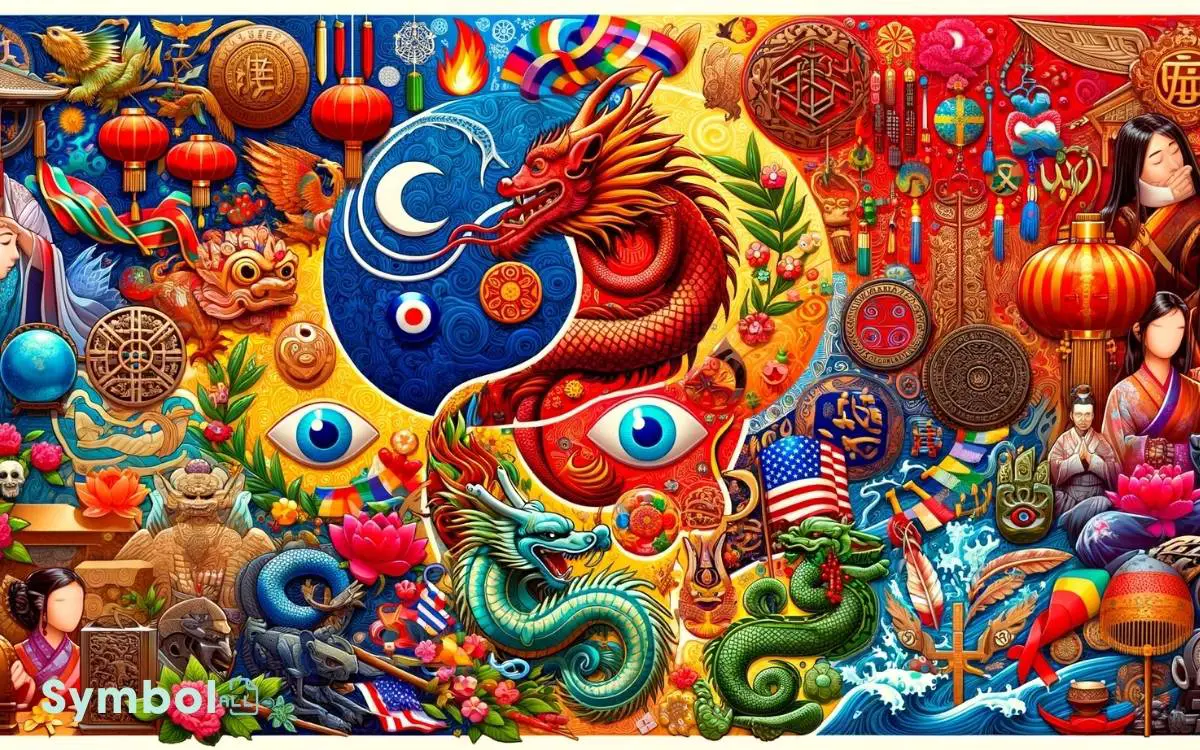Color Symbolism in Different Cultures: Explains!
Colors aren’t just visual; they’re deeply symbolic, weaving rich narratives across cultures. Red, for example, walks a fine line between love and danger, signaling prosperity in some cultures and caution in others.
White, often symbolizing purity, takes a somber turn in Eastern traditions, where it’s worn at funerals. Blue calms, representing tranquility and wisdom, while green contrasts growth with envy.
These colors’ meanings vary widely, from mourning with black to celebrating with gold. Each hue holds a kaleidoscope of meanings, embodying complex cultural expressions and emotions. You’ll discover that every color tells a multifaceted story, inviting you to explore further.

Key Takeaways
7 Color Symbolism Chart in Different Cultures
| Color | Western Cultures | Eastern Cultures | Middle Eastern Cultures | African Cultures | Latin American Cultures |
|---|---|---|---|---|---|
| Red | Love, Passion, Danger | Prosperity, Celebration | Danger, Evil | Sacrifice, Courage | Love, Passion |
| Blue | Trust, Serenity | Immortality, Tranquility | Healing, Trust | Innocence, Peace | Trust, Integrity |
| Green | Growth, Freshness | Eternity, Health | Fertility, Luck | Fertility, Freshness | Hope, Fertility |
| Yellow | Happiness, Optimism | Sacred, Imperial | Wisdom, Patience | Wealth, Fertility | Joy, Energy |
| White | Purity, Peace | Death, Mourning | Purity, Mourning | Spirituality, Ancestors | Peace, Purity |
| Black | Death, Evil | Fortune, Health | Mystery, Mourning | Power, Evil | Death, Mourning |
| Purple | Royalty, Luxury | Wealth, Nobility | Wealth, Wisdom | Royalty, Sacred | Nobility, Spirituality |
The Power of Red
Red, a color of both passion and danger, holds varying significance across cultures, often symbolizing love, luck, and power, or conversely, warning and prohibition.
You’ll find that in Eastern cultures, red is mainly seen as a harbinger of prosperity and happiness, deeply embedded in celebrations and ceremonies.
It’s the color of choice for brides in India, signifying purity and fertility, while in China, it encapsulates good fortune and joy, used extensively in New Year celebrations and weddings.
Conversely, in the West, red often signals caution, commanding attention in traffic lights and signs. This duality of red, oscillating between allure and alarm, underscores its profound psychological impact, influencing behavior and perceptions.
The symbolism of red isn’t just a matter of aesthetics but a complex interplay of cultural values and emotions.
White: Purity and Mourning
Unlike red, white often embodies purity and innocence in many cultures, yet it also represents mourning and grief in others. This duality offers a fascinating contrast, illuminating the diverse interpretations of color across the world.
Consider how:
- In Western cultures, white is synonymous with weddings, symbolizing a fresh start and purity.
- Contrastingly, in many Eastern cultures, white garments are worn at funerals, signifying mourning and the soul’s departure.
- This dichotomy extends to religious practices, where white can denote both sanctity and, paradoxically, death.
- The perception of white as either pure or mournful underscores the importance of context in understanding color symbolism.
This nuanced interpretation invites you to appreciate the complexity and cultural significance of white, beyond its simplistic view as merely a color.
Blues Calming Influence
Across cultures, blue’s calming influence often symbolizes tranquility and stability, contrasting sharply with the vibrant energy of colors like red. You’ll find that in many societies, blue embodies a soothing presence, evoking feelings of peace and serenity.
This isn’t by accident. Psychologically, blue has a cooling effect, slowing down the human metabolism and fostering a sense of mental relaxation. It’s why you’ll see blue in environments meant to calm, from hospital wards to bedrooms.
Furthermore, blue’s significance transcends mere aesthetics. In some cultures, it represents trust, loyalty, and wisdom, qualities deeply rooted in stability and calmness.
This universal appeal makes blue a color that not only calms the mind but also unites diverse cultures under a common symbol of tranquility.
Yellow: Joy and Caution
Yellow’s dual nature captures hearts with its brightness, signaling joy and optimism, yet it also warns of caution and danger in various cultural contexts.
You’ll find this color playing dual roles:
- In Western cultures, yellow often symbolizes happiness and warmth, making it a go-to for cheerful designs.
- Yet, it’s also the color of caution think traffic signs and hazard warnings, alerting you to potential danger.
- In some Eastern cultures, yellow holds a sacred significance, associated with royalty and spiritual purity.
- Conversely, it can signify sickness or jealousy, underscoring its cautionary aspect in interpersonal relationships.
Analyzing yellow’s symbolism reveals a fascinating blend of joy and caution, reflecting cultural nuances that influence how we perceive and interact with this vibrant color.
Green: Nature and Envy
One often associates green with the vibrancy of nature, yet it also harbors sentiments of envy across different cultures. In many societies, green symbolizes growth, renewal, and life. It’s the color that blankets forests and fields, signaling fertility and abundance.
This linkage is almost universal, transcending geographical and cultural boundaries, reflecting humanity’s deep connection with the environment.
Conversely, green’s association with envy is intriguingly consistent, though its origins are more nuanced. The phrase ‘green with envy’ suggests a sickly, unnatural state, as if one’s natural balance is disrupted by desire for what another possesses.
This dual symbolism of green showcases its complexity. It’s a color that can evoke feelings of peace and contentment through its connection to nature, yet cautionary tales remind you that it also represents the darker side of human emotion.
Black: Mystery and Loss
As you explore the multifaceted symbolism of black, you’ll find it’s not just a marker of mystery and loss. Its elegance in fashion contrasts sharply with its role in mourning traditions worldwide, a dichotomy that speaks volumes about cultural perceptions.
Additionally, black’s natural association with night ties it to universal human experiences, creating a bridge between the personal and the collective.
Elegance in Fashion
In the world of fashion, black embodies elegance, often carrying connotations of mystery and loss that vary greatly across different cultures. When you don this color, you’re not just wearing a garment; you’re embracing a rich tapestry of meanings that transcend boundaries.
Here’s how black in fashion compares across various cultures:
- Western Cultures: Black is synonymous with sophistication and timeless style, often chosen for its slimming effect and formal appearance.
- Eastern Traditions: In countries like Japan, black can symbolize experience and wisdom, making it a preferred color for formal attire.
- African Influence: Black celebrates heritage and strength, often incorporated into patterns that hold cultural significance.
- Contemporary Interpretations: Globally, black is seen as a powerful statement of individuality and rebellion against conventional norms.
Understanding these nuances offers a glimpse into the profound impact colors have on fashion and culture worldwide.
Mourning Traditions Worldwide
While black symbolizes elegance and style in fashion, it also holds deep associations with mourning and loss across various cultures, reflecting diverse traditions and beliefs about death and the afterlife.
In the West, black attire is commonly worn at funerals, symbolizing grief and respect for the deceased. This tradition contrasts sharply with Eastern cultures, where white often represents mourning, purity, and rebirth.
Yet, in some African and Asian societies, black still signifies loss but is also intertwined with honoring ancestors and facilitating the spiritual journey of the departed. These differences highlight how cultural contexts shape the meanings attributed to colors.
Nights Natural Association
Black’s association with night extends beyond a mere absence of light, embodying mysteries and the profound depth of loss experienced by cultures around the globe.
This natural connection offers you a deeper understanding of black’s symbolism, reflecting:
- Mystery: Night’s veil encourages a sense of the unknown, where cultures see black as a canvas for the unseen and undiscovered.
- Loss: It symbolizes the emptiness felt in darkness, akin to the void left by losing something or someone dear.
- Protection: Just as night cloaks the earth, black represents a protective barrier against negative influences in many traditions.
- Transition: Night leads to day; similarly, black signifies change and the passage through life’s darker moments towards renewal.
This multifaceted symbolism of black, tied to night’s natural association, enriches our cultural understanding of color.
The Dual Faces of Orange
As you explore the vibrant hue of orange, you’ll find it embodies a fascinating duality across cultures. Its role in spirituality often contrasts sharply with its use as a signal for caution, reflecting a spectrum that ranges from divine connection to worldly warning.
This complexity is further nuanced by global perceptions, where orange can signify everything from warmth and celebration to stark alerts, depending on the cultural context.
Orange in Spirituality
Why does orange evoke such contrasting spiritual meanings across different cultures, embodying both sacredness and caution?
Here’s a breakdown:
- In Hinduism, orange symbolizes fire, purity, and religious abstinence. It’s the color of the holy men and women who’ve renounced the world.
- Buddhism sees orange as the hue of illumination, representing the quest for enlightenment. It’s the color of wisdom and strength.
- In Western cultures, orange can signify caution in spiritual contexts, often used to signal change or prepare one for a spiritual warning.
- For some Indigenous cultures, orange is sacred, representing healing and protection, guiding the community through spiritual practices.
Analyzing these perspectives, you find orange’s duality is deeply rooted in how societies interpret its vibrancy and visibility, making it a fascinating study of cultural contrasts.
Orange: Warmth Vs. Warning
Orange effortlessly bridges the gap between warmth and warning, serving as a vivid proof to its dual significance across various contexts. You’ll find that its presence can both comfort and caution, depending on where you are and what you’re dealing with.
| Aspect | Warmth | Warning |
|---|---|---|
| Context | Home decor | Road signs |
| Emotion | Joy and energy | Caution |
| Nature | Autumn leaves | Wildfire alerts |
This table illustrates how orange can evoke feelings of joy and energy or signal caution and alertness. Its duality isn’t just fascinating; it’s a confirmation of the complexity of cultural interpretations.
As you navigate through different settings, you’ll start to appreciate how this vibrant color can guide, warn, or even embrace you with its warmth.
Global Perceptions of Orange
Exploring the global perceptions of orange reveals its dual faces, where its warmth and warning tones resonate differently across cultures.
Here’s how:
- In the Netherlands, orange symbolizes national pride and royalty, displaying warmth and unity during national celebrations.
- In the United States, it’s often associated with Halloween and fall, evoking feelings of warmth, harvest, and shift, yet also warning through its use in safety gear.
- In Hinduism, it represents sacredness and purity, worn during religious ceremonies to convey spirituality and peace.
- In Buddhist cultures, monks’ robes are orange, symbolizing simplicity and detachment from materialism, yet cautioning against excess.
These diverse perceptions show how orange’s vibrancy can either embrace or caution, making it a truly unique color in global symbolism.
Pink: Softness and Strength
In various cultures, pink embodies both softness and strength, challenging traditional perceptions of color symbolism. You’ll find it fascinating how pink’s duality reflects cultural nuances and evolves over time.
Historically, pink was considered a diminutive of red, embodying its power and passion in a softer, more accessible form. In Western societies, pink has often been associated with femininity and tenderness, suggesting a delicate strength.
Contrastingly, in some Asian cultures, pink carries a warrior-like significance, particularly in Japan where samurais would don pink to symbolize life and combat readiness.
This juxtaposition highlights pink’s ability to transcend simplistic categorizations, embodying a spectrum of meanings from nurturing love to fierce bravery.
Its versatility underscores the complexity of cultural interpretations, inviting you to rethink color symbolism in a global context.
Purple: Royalty and Spirituality
You’ll find that purple’s significance transcends mere aesthetics, embodying both grandeur and spirituality across various cultures.
While its association with royalty is rooted in the rarity and costliness of purple dye in ancient times, the color’s spiritual connections often symbolize mystery, magic, and meditation.
Comparing how different societies interpret purple reveals a fascinating spectrum of values, from power and wealth to wisdom and introspection.
Purples Royal Significance
While often associated with luxury and power, purple’s significance extends deeply into the worlds of royalty and spirituality across various cultures.
Analyzing its royal connotations, you’ll find:
- Historical Rarity: Originally, purple dye was incredibly rare and expensive, sourced from the Phoenician trading city of Tyre. This rarity made it a status symbol among ancient royalty.
- Legislative Exclusivity: In Rome, laws restricted the use of purple clothing to the emperor and his immediate family, underlining its exclusivity.
- Symbol of Power: European monarchs and the church adopted purple as a color of authority and sovereignty.
- Cultural Variations: While Western cultures see purple as regal, other cultures mightn’t place the same emphasis on it, showing the fluidity of color symbolism.
This comparative analysis highlights purple’s nuanced role in symbolizing royalty, distinct yet interconnected across cultures.
Spiritual Connections to Purple
Beyond its royal connotations, purple also holds profound spiritual significance across various cultures, serving as a bridge between the material and the mystical.
You’ll find that in spiritual practices, purple symbolizes higher consciousness and spiritual awakening. This is due to its association with the Crown Chakra, which is believed to be the gateway to the divine or the universe’s infinite consciousness.
When comparing eastern and western spiritual traditions, both hold purple in high esteem, albeit for slightly different reasons. In the East, it’s often seen as a color of enlightenment and inner peace, while in the West, it can represent penitence and faith.
This duality showcases purple’s unique ability to transcend the physical, connecting you with the celestial planes of spirituality and introspection.
Cultural Interpretations of Purple
Throughout various cultures, purple’s embodiment of royalty and spirituality offers a fascinating glimpse into how color shapes societal values and beliefs.
- In ancient Rome, purple robes were exclusive to emperors, symbolizing power and wealth due to the rarity and cost of the dye.
- In Japan, the color represents privilege and aristocracy, worn historically by the highest-ranking officials.
- Western societies often associate purple with luxury and sophistication, a nod to its royal connotations.
- Spiritually, purple is significant in Tibetan Buddhism, signifying purity and devotion.
These cultural interpretations highlight the diverse meanings of purple, reflecting both material status and the pursuit of higher spiritual ideals. You’ll find that purple’s significance varies, yet it consistently denotes a sense of the extraordinary across different societies.
Brown: Earth and Stability
In many cultures, brown represents the earth and stability, serving as a grounding force in both art and symbolism. You’ll find that its significance transcends mere aesthetics, embodying qualities such as reliability, resilience, and endurance.
This color’s association with the earth isn’t coincidental; it’s deeply rooted in the universal human experience of connecting with the land for sustenance and shelter.
In contrast to more vibrant hues, brown’s subtlety encourages a sense of security and comfort, reflecting life’s foundational elements.
Whether in the textiles of South America, the pottery of ancient civilizations, or the fashion of modern societies, brown consistently symbolizes a return to basics, a reminder of the natural cycle, and the importance of a stable foundation in both physical and metaphorical senses.
The Complexity of Gold
Gold’s allure captivates cultures worldwide, embodying wealth, power, and divine grace with a complexity that transcends its mere material value.
You’ll find its significance varies, yet some themes are universally recognized:
- Immortality: In many myths, gold is the metal of the gods, symbolizing eternal existence.
- Purity: Its resistance to tarnish and corrosion has made gold a metaphor for purity and truth across various religions.
- Prosperity: From ancient currencies to modern finance, gold signifies economic stability and wealth accumulation.
- Celebration: In numerous cultures, gold is integral to wedding ceremonies and festive decorations, highlighting joy and success.
Analyzing gold’s symbolism reveals a shared human fascination with this precious metal, while also uncovering unique cultural interpretations that enrich our global tapestry.
Silver: Innovation and Tradition
Silver, often seen as the understated counterpart to gold, weaves a narrative of innovation and tradition across cultures, reflecting both progress and heritage.
In the East, silver’s luminosity symbolizes purity and clarity, guiding spiritual practices and architectural designs. It’s integrated into rituals and ceremonies, bridging the material with the spiritual domain.
Conversely, in Western contexts, silver denotes technological advancement and futuristic visions, embodying the sleek aesthetics of modernity and the promise of innovation. This duality showcases how silver, while universally valued, narrates distinct cultural stories.
It’s not just a metal but a medium through which societies express their values around continuity and change, anchoring the past while propelling towards the future. You’ll find that it’s this balance that makes silver’s symbolism uniquely compelling.
Cultural Significance of Grey
Although often overshadowed by more vibrant colors, grey holds its own unique cultural significance, reflecting a spectrum of meanings from neutrality to sophistication across different societies.
- In Western cultures, you’ll find grey symbolizing neutrality and balance, often associated with professionalism and corporate environments. It’s a color that doesn’t compete for attention, yet conveys a sense of stability.
- Eastern traditions, particularly in Japan, view grey as a color of modesty and reliability. It’s woven into the fabric of everyday life, from architecture to fashion, embodying a quiet strength.
- In some African cultures, grey can represent healing and cleansing, as it’s the color of rain clouds bringing much-needed water to the land.
- Meanwhile, in Nordic countries, grey’s connection to their often overcast skies brings a sense of calm and reflection, highlighting its adaptability and depth across different contexts.
Conclusion
In the tapestry of human culture, colors weave a complex narrative, each hue holding a dual-edged sword of meaning.
Like rivers, they cut through the landscape of our perceptions, sometimes nurturing life with their symbolic richness, at times eroding it with misunderstanding.
As you navigate the vibrant spectrum, remember, colors aren’t just seen; they’re felt, shaping our world in ways as diverse as the cultures that cherish them. Dive deep, for in their depths lies a universal language, waiting to be deciphered.






